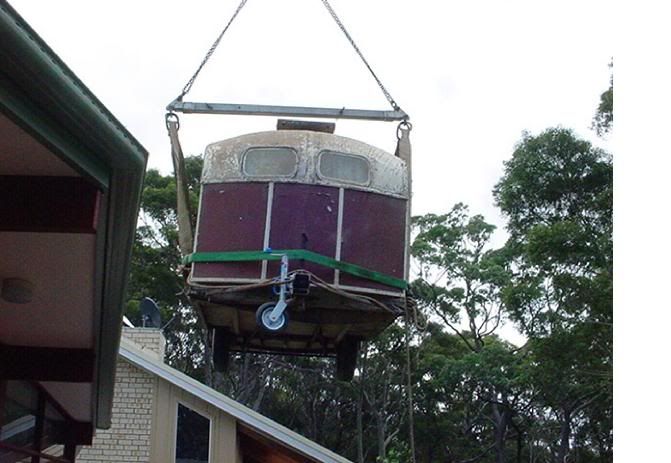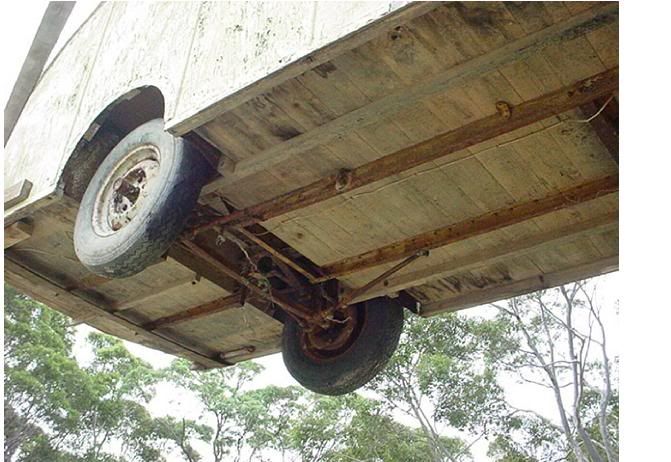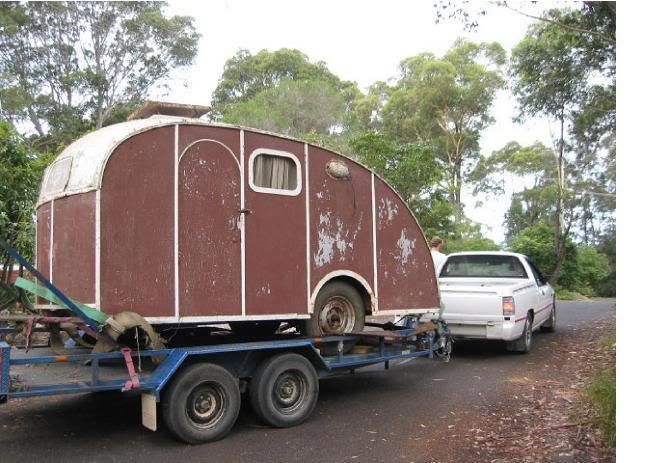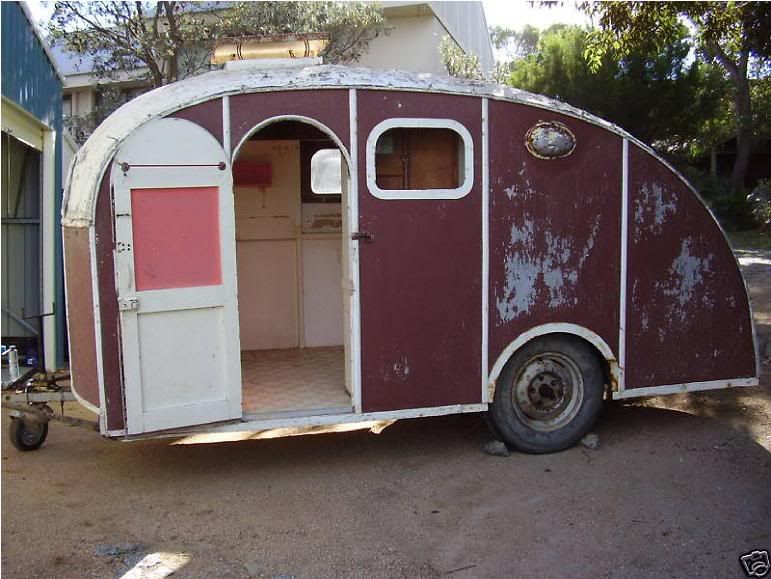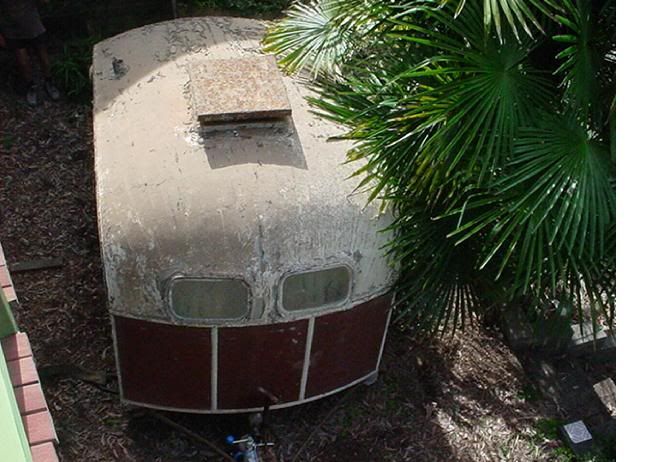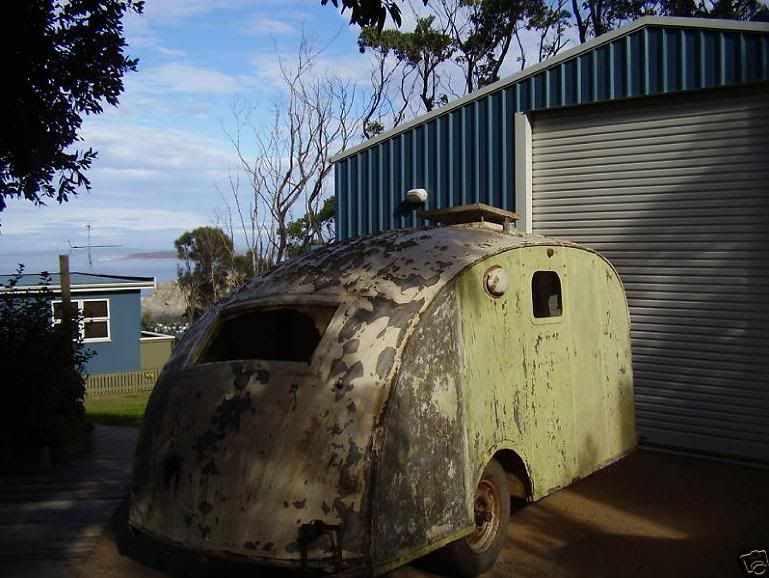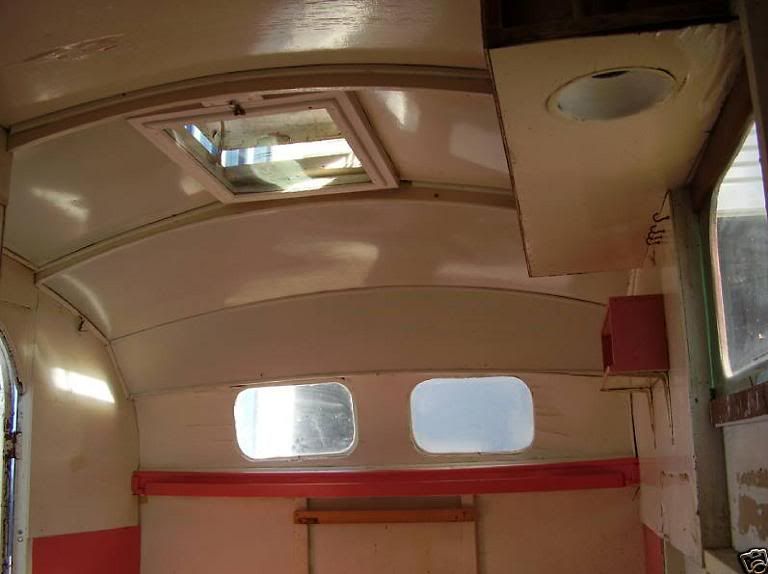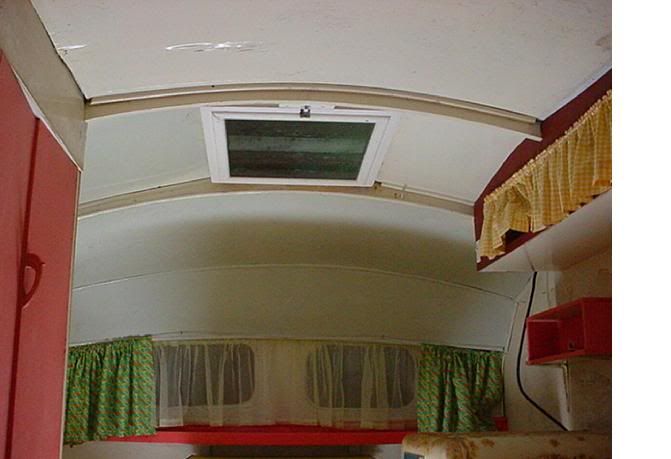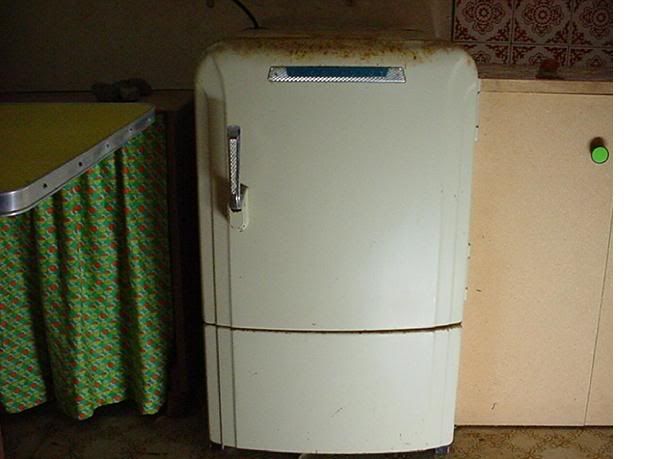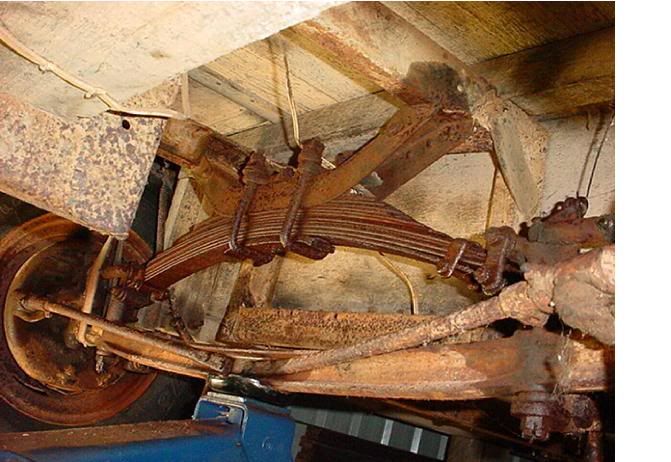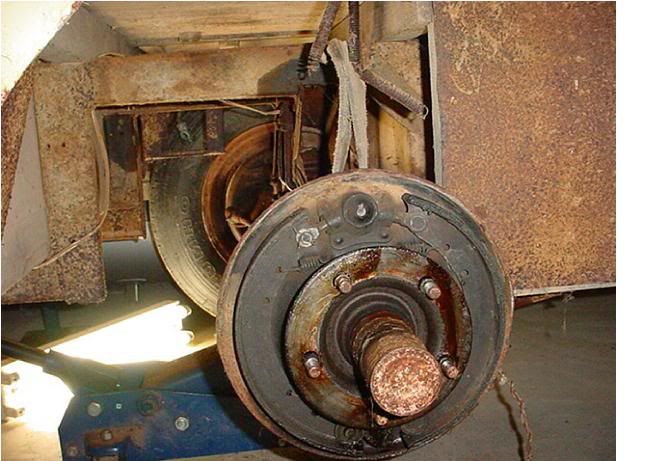Post by Don Ricardo on Mar 7, 2010 18:13:52 GMT 10
RUNLITE TEARDROP caravan built from plans in the 1938 edition of American Modern Mechanics Magazine How-To-Build-It.
Builder unknown
On 19 March 2006, Kingy wrote:
"Can anyone out there shed any light on what I have here.
I'm yet to get in touch with the owner who's apparantly in Germany, but I'm told the vans got to go because of ext's to the house,so here's hoping it ends up in my shed. Hope someone can help.
Cheers Kingy"
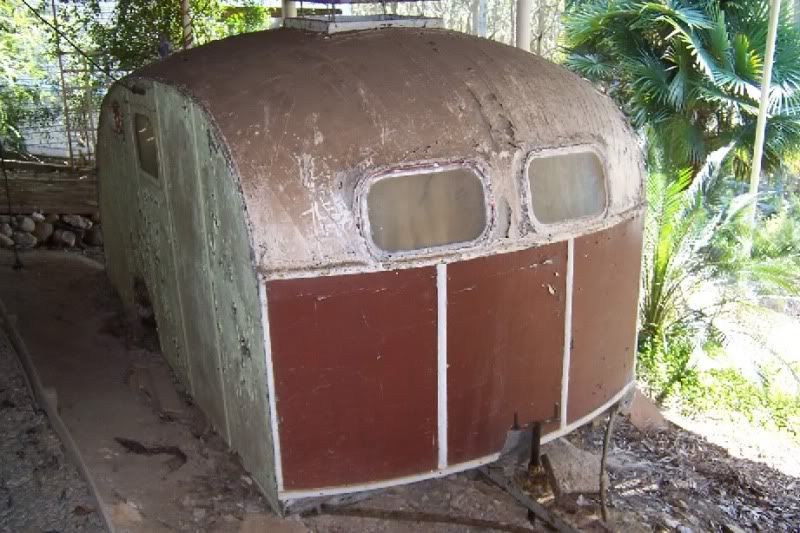
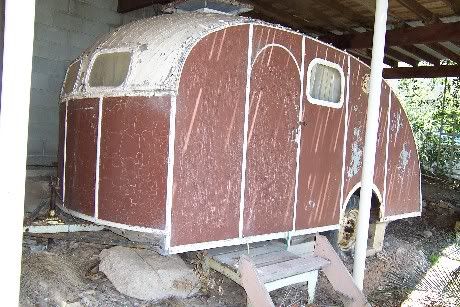
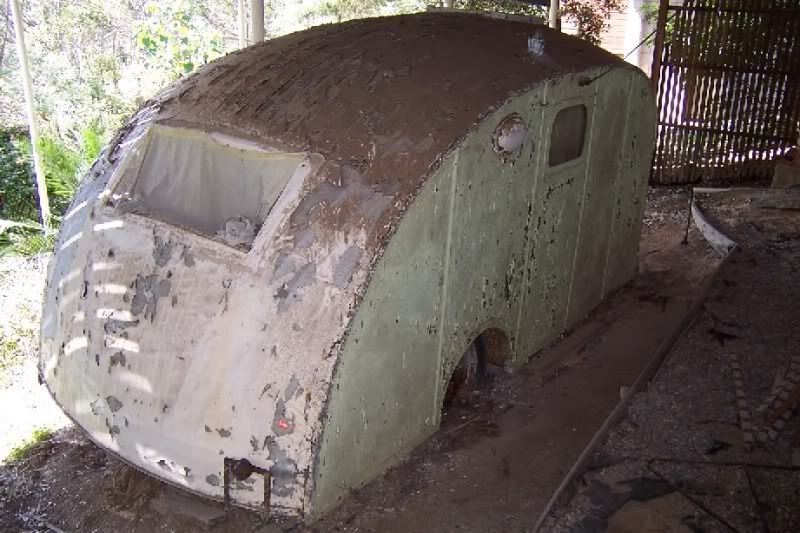
In response to a question Kingy added:
"She's all ply from what i can see, i did"nt stay long (just long enough to take pics) as i said owners are o.s.
Looks like its been there for a bloody long time as they have built a verandah around and over it which would be 20-30 yrs old. I'll speak to the guy who put me on to it shortly and try to get in touch with the owner before its destroyed. Fingers crossed."
The caravan was subsequently purchased by Imrightjack (John), who posted the following on 25 March 2006
"Hello all, good to make contact, I’m John, the bloke that now owns the van... I had so much organising to do in removing this caravan and on top of this I was discovering how others viewed the caravan’s uniqueness through this forum.
So this is how things happened.
I made a comment to the neighbour about how unique and old this caravan was and what a great restoration project it would make. I was told I was the first person who had expressed an interest in recovering or salvaging it. The caravan had been sitting under this house for the past 36 years and was known to have been there a further 5 years. I have not f/up earlier history given on previous owners prior to this time. I was asked to remove this caravan at any cost just to get rid of it as it was considered to be an eye sore to the owners and their neighbours. The owner’s believed the only possible way to get rid of it was to dissect it and then take it to the tip. This was due to the impossibility of removal because it was located under the home that had decking built around it on a steep slope with no access to the road. I was asked if I was interested in the job of removal.
The owner rejected the idea of partial demolition of deck to extract the caravan. With no other access available craning the caravan was the only option. Having consulted with a crane operator I was advised it would be a tricky job due to the power wires, trees, slope etc. All agreed to give it a go and it worked without any damage to the caravan, deck or home. I cleaned up the site and thanked all who were really excited that the caravan was gone and that it would be saved to be restored.
I have the 12 rocks found on the mattress and outside that the little boy next door threw through the perspex back window and at the rear section of the van (on a positive note probably the only damage sustained in the last 50 years). Thankfully justice was served and I’m told he got two hidings, one for doing it and another for not owning up to it.
Hoping to get involved and share pics and find out more about this caravan by taking on board your ideas and inputs. They would be greatly appreciated given the fact that there is so little information about this caravan. Personally I have not been able to find a caravan that remotely even resembles this one.
I might add that the roof is curved by slates covered by painted canvas and the uniqueness of the design resembles early air craft construction methods. Good news, despite the van sitting within site of the ocean with its deteriorated appearance the van is in remarkably good condition with hardly any timber rot to be found. And get this, all the wheel nuts unbolted easily and the wheels still spin nicely over the old drum brakes. It has a full leaf spring suspension set up above the curved axel. The full metal chasse is in good condition with surface rust only and the front dolly wheel wound up with ease. We have yet to find any name or numbers on the van except for a brand name on the rubber tyre on the jockey wheel (Kenwort) and on the jockey wheel housing assembly (Dymwood) Regards John"
Imrightjack posted the further information over the following month, culminating in its identification:
28 March 2006: "Hi All,
Axil assembly comprises of a full front end including drum brakes with no shock absorbers or stablilizers at all. Complete front full suspension mounted on a full chassis. The tie rod ends have both been bolted to the centre of the axil to stop any steering movement.
Yes Col, the Van does rock and roll side ways easily and the axil spring combo does take up a hugh amount of floor space under the bed area.
We are working towards getting some great pics of the van being lifted out by the 20 ton crane. There will be clear pics of the axil assembly and also inside shots of the van etc that will answer lots of your questions.
No ID marks to be found yet. Thanks to all for your points of view. I think I’m hooked on these old vans now. Cheers John"
2 April 2006: "Hello all,
Col, you have described the brakes exactly how they are and yes they did appear to have been in working order before the cables to the front lever on the coupling rusted out years ago. I have included pics of the braking system and the front brake lever? (set up). Thanks for the info Col.
Had an older builder friend check the Van out yesterday and I asked him his opinion of the construction materials used for the van. He reckons the flooring which is a tongue and grove Baltic Pine was commonly imported into the country in that time and the railings and the framing timbers appear to be Australian hardwood. His guess was that it was made in Australia in a factory not a back yard due to the specialty workmanship required in the construction of the canvas covered slatted roof. Regards ImRightJack"
17 April 2006: "Good news…….. !
I can finally say I know exactly the origins of my van.
It’s taken a heck of a lot of research and I have to say I’m cheering to have some answers. The caravan is called a Runlite Teardrop. After looking at the original blueprints taken from the American Modern Mechanics Magazine How-To-Build-It 1938 Edition, it’s built to the exact specs but of a much larger size. The original Runlite Teardrop was a very small compact travelling bedroom and the yanks have not seen anything as big as this one from the Runlite blueprints.
So American plans and I would guess Australian built.
The caravan has been constructed directly from these plans using a more complex approach due to the height/width/length and weight modifications.
The person/s that made the changes and built this must have really known what they were doing. You certainly can not fault the workmanship on what would have been a very challenging project, and it has been suggested on the following forum that Model A Ford parts dated from 1928 – 1931 have been used in the suspension chassis set up.
I made contact with Teardrops & Tiny Travel Trailers in America who seemed very impressed with the find and have given encouraging feedback on there website that I might add is also very impressive.
www.mikenchell.com/forums/viewtop....ade5baa1e5cc1b7
ImRightJack"
Sadly a number of the photos which accompanied these posts are no longer accessible.
Builder unknown
On 19 March 2006, Kingy wrote:
"Can anyone out there shed any light on what I have here.
I'm yet to get in touch with the owner who's apparantly in Germany, but I'm told the vans got to go because of ext's to the house,so here's hoping it ends up in my shed. Hope someone can help.
Cheers Kingy"



In response to a question Kingy added:
"She's all ply from what i can see, i did"nt stay long (just long enough to take pics) as i said owners are o.s.
Looks like its been there for a bloody long time as they have built a verandah around and over it which would be 20-30 yrs old. I'll speak to the guy who put me on to it shortly and try to get in touch with the owner before its destroyed. Fingers crossed."
The caravan was subsequently purchased by Imrightjack (John), who posted the following on 25 March 2006
"Hello all, good to make contact, I’m John, the bloke that now owns the van... I had so much organising to do in removing this caravan and on top of this I was discovering how others viewed the caravan’s uniqueness through this forum.
So this is how things happened.
I made a comment to the neighbour about how unique and old this caravan was and what a great restoration project it would make. I was told I was the first person who had expressed an interest in recovering or salvaging it. The caravan had been sitting under this house for the past 36 years and was known to have been there a further 5 years. I have not f/up earlier history given on previous owners prior to this time. I was asked to remove this caravan at any cost just to get rid of it as it was considered to be an eye sore to the owners and their neighbours. The owner’s believed the only possible way to get rid of it was to dissect it and then take it to the tip. This was due to the impossibility of removal because it was located under the home that had decking built around it on a steep slope with no access to the road. I was asked if I was interested in the job of removal.
The owner rejected the idea of partial demolition of deck to extract the caravan. With no other access available craning the caravan was the only option. Having consulted with a crane operator I was advised it would be a tricky job due to the power wires, trees, slope etc. All agreed to give it a go and it worked without any damage to the caravan, deck or home. I cleaned up the site and thanked all who were really excited that the caravan was gone and that it would be saved to be restored.
I have the 12 rocks found on the mattress and outside that the little boy next door threw through the perspex back window and at the rear section of the van (on a positive note probably the only damage sustained in the last 50 years). Thankfully justice was served and I’m told he got two hidings, one for doing it and another for not owning up to it.
Hoping to get involved and share pics and find out more about this caravan by taking on board your ideas and inputs. They would be greatly appreciated given the fact that there is so little information about this caravan. Personally I have not been able to find a caravan that remotely even resembles this one.
I might add that the roof is curved by slates covered by painted canvas and the uniqueness of the design resembles early air craft construction methods. Good news, despite the van sitting within site of the ocean with its deteriorated appearance the van is in remarkably good condition with hardly any timber rot to be found. And get this, all the wheel nuts unbolted easily and the wheels still spin nicely over the old drum brakes. It has a full leaf spring suspension set up above the curved axel. The full metal chasse is in good condition with surface rust only and the front dolly wheel wound up with ease. We have yet to find any name or numbers on the van except for a brand name on the rubber tyre on the jockey wheel (Kenwort) and on the jockey wheel housing assembly (Dymwood) Regards John"
Imrightjack posted the further information over the following month, culminating in its identification:
28 March 2006: "Hi All,
Axil assembly comprises of a full front end including drum brakes with no shock absorbers or stablilizers at all. Complete front full suspension mounted on a full chassis. The tie rod ends have both been bolted to the centre of the axil to stop any steering movement.
Yes Col, the Van does rock and roll side ways easily and the axil spring combo does take up a hugh amount of floor space under the bed area.
We are working towards getting some great pics of the van being lifted out by the 20 ton crane. There will be clear pics of the axil assembly and also inside shots of the van etc that will answer lots of your questions.
No ID marks to be found yet. Thanks to all for your points of view. I think I’m hooked on these old vans now. Cheers John"
2 April 2006: "Hello all,
Col, you have described the brakes exactly how they are and yes they did appear to have been in working order before the cables to the front lever on the coupling rusted out years ago. I have included pics of the braking system and the front brake lever? (set up). Thanks for the info Col.
Had an older builder friend check the Van out yesterday and I asked him his opinion of the construction materials used for the van. He reckons the flooring which is a tongue and grove Baltic Pine was commonly imported into the country in that time and the railings and the framing timbers appear to be Australian hardwood. His guess was that it was made in Australia in a factory not a back yard due to the specialty workmanship required in the construction of the canvas covered slatted roof. Regards ImRightJack"
17 April 2006: "Good news…….. !
I can finally say I know exactly the origins of my van.
It’s taken a heck of a lot of research and I have to say I’m cheering to have some answers. The caravan is called a Runlite Teardrop. After looking at the original blueprints taken from the American Modern Mechanics Magazine How-To-Build-It 1938 Edition, it’s built to the exact specs but of a much larger size. The original Runlite Teardrop was a very small compact travelling bedroom and the yanks have not seen anything as big as this one from the Runlite blueprints.
So American plans and I would guess Australian built.
The caravan has been constructed directly from these plans using a more complex approach due to the height/width/length and weight modifications.
The person/s that made the changes and built this must have really known what they were doing. You certainly can not fault the workmanship on what would have been a very challenging project, and it has been suggested on the following forum that Model A Ford parts dated from 1928 – 1931 have been used in the suspension chassis set up.
I made contact with Teardrops & Tiny Travel Trailers in America who seemed very impressed with the find and have given encouraging feedback on there website that I might add is also very impressive.
www.mikenchell.com/forums/viewtop....ade5baa1e5cc1b7
ImRightJack"
Sadly a number of the photos which accompanied these posts are no longer accessible.


